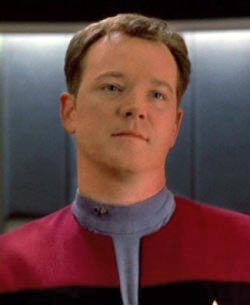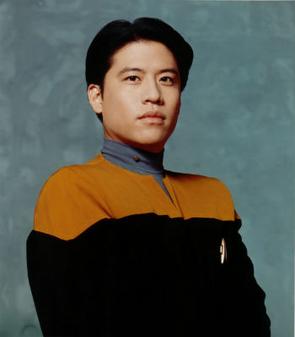Related Research Articles

The Doctor, an Emergency Medical Hologram (EMH), is a fictional character portrayed by actor Robert Picardo in the television series Star Trek: Voyager, first aired on UPN between 1995 and 2001. He is an artificial intelligence manifest as a holographic projection, and designed to be a short-term adjunct to medical staff in emergency situations. However, when the USS Voyager is stranded on the far side of the galaxy without medical personnel, he is forced to act as the starship's permanent chief medical officer. In an example of the Star Trek franchise's exploration of artificial intelligence, a simple software program becomes a major character in the show.

Lieutenant Thomas Eugene "Tom" Paris is a fictional character in the American science fiction television series Star Trek: Voyager and is portrayed by Robert Duncan McNeill. Paris is the chief helmsman, as well as a temporary auxiliary medic, of the USS Voyager, a Starfleet ship that was stranded in the Delta Quadrant by an alien entity known as the Caretaker.
Star Trek: Voyager is an American science fiction series created by Rick Berman, Michael Piller and Jeri Taylor. It aired from January 16, 1995, to May 23, 2001, on UPN, with 172 episodes over seven seasons. The fifth series in the Star Trek franchise, it served as the fourth after Star Trek: The Original Series. Set in the 24th century, when Earth is part of a United Federation of Planets, it follows the adventures of the Starfleet vessel USS Voyager as it attempts to return home to the Alpha Quadrant after being stranded in the Delta Quadrant on the far side of the galaxy.
"Someone to Watch Over Me" is the 116th episode of the science fiction television series Star Trek: Voyager, the 21st episode of the fifth season. It was directed by cast member Robert Duncan McNeil.
"Phage" is the fifth episode of the first season of the American science fiction television series Star Trek: Voyager. The episode was directed by Winrich Kolbe. Set in the 24th century, the series follows the adventures of the Starfleet and Maquis crew of the starship USS Voyager after they are stranded in the Delta Quadrant far from the rest of the Federation.
"The Cloud" is the sixth episode of the television series Star Trek: Voyager. The teleplay was written by Tom Szolosi and Michael Piller, based on a story by Brannon Braga, and directed by David Livingston.
"Body and Soul" is the 153rd episode of Star Trek: Voyager, the seventh episode of the seventh season. This television episode is one installment of a science fiction series involving a spacecraft trying to get back to Earth from the other side of the Galaxy. The show aired on the United Paramount Network on November 15, 2000. It is focused especially on two characters, Seven of Nine and the holographic medical program called the Doctor. The episode was noted for its humor and acting performances in reception.
"Projections" is the 19th episode of the American science fiction television program Star Trek: Voyager. Originally slated for the first season, the episode originally aired on UPN on September 11, 1995, and tells the story of the ship's holographic doctor suffering an identity crisis on the holodeck regarding whether he or the world around him is the illusion.
"Repentance" is the 159th episode of the American science fiction television series Star Trek: Voyager airing on the UPN network. It is the 13th episode of the seventh season.
"Heroes and Demons" is the twelfth episode of the first season of the American science fiction television series Star Trek: Voyager. The episode first aired April 24, 1995 on UPN. It was directed by Les Landau and written by former Star Trek: The Next Generation story editor Naren Shankar. Set in the 24th century, the series follows the adventures of the Starfleet and Maquis crew of the starship USS Voyager after they were stranded in the Delta Quadrant far from the rest of the Federation. In this episode, after a sample of a protostar is brought on board, crewmen start to vanish from a holodeck simulation of Beowulf. The Doctor, a hologram, investigates and finds that a lifeform was transported to the ship alongside the sample. It escaped to the holodeck where it was converting those who entered into energy. The Doctor has the samples brought to the holodeck and released, resulting in the lifeform returning the crewmen to their corporeal states.
"Twisted" is the 22nd episode of Star Trek: Voyager, the sixth episode in the second season. Set in the 24th century, the Starfleet ship U.S.S. Voyager is stranded in the Delta Quadrant on the opposite side of the Galaxy from Earth in the Alpha Quadrant. In this episode, a spacial anomaly distorts the ship and the crew must work through their relationships amidst difficult and constantly changing surroundings.
"Workforce" is a two-part episode from the seventh and final season of the TV series Star Trek: Voyager. Part one was directed by Allan Kroeker, and part two by Roxann Dawson. The crew of the USS Voyager finds themselves working on a planet, but troubling memories are resurfacing.
"Author, Author" is the 166th episode of the TV series Star Trek: Voyager, the 20th episode of the seventh season. This episode focuses on the character "The Doctor" (EMH) and on impact of a novel and explores the meaning of AI.
"The Killing Game" is a two-part episode of the science fiction television series Star Trek: Voyager, the 18th and 19th episodes of the fourth season. It is set in the 24th century aboard a starship returning to Earth after having been stranded on the other side of the Galaxy.
"Macrocosm" is the 54th episode of Star Trek: Voyager, the 12th episode of the third season. The title borrows the philosophical term macrocosm, definable as a larger world that mirrors what exists in a miniature world, or microcosm.
"11:59" is the 117th episode of the science fiction television series Star Trek: Voyager, the 23rd episode of the fifth season.
"Fair Haven" is the eleventh episode from the sixth season of the science fiction television series Star Trek: Voyager, 131st episode overall. The crew of starship USS Voyager explore a holodeck program crafted by Tom Paris, set in Ireland, meanwhile Voyager encounters a space storm. The show focuses on the experiences of Captain Janeway during this time.
"Flesh and Blood" is a two-part episode from the seventh season of the science fiction television series Star Trek: Voyager. The crew of USS Voyager must contend with violent Delta Quadrant aliens the Hirogen, who use the holodeck technology with a horrific amoral twist.

Ensign Harry S. L. Kim is a fictional character who appeared in each of the seven seasons of the American television series Star Trek: Voyager. Portrayed by Garrett Wang, he is the Operations Officer aboard the Starfleet starship USS Voyager.
References
Citations
- 1 2 Pirrello, Phil (2020-01-16). "The 15 greatest Star Trek: Voyager episodes, ranked". SYFY WIRE. Retrieved 2020-01-19.
- ↑ "Tinker Tenor Doctor Spy". Lost in Space: Star Trek Voyager. Retrieved 2007-08-28.
- 1 2 Perenson, Melissa J. "Star Trek: Voyager's Robert Picardo considers the journey home". SciFi.com. Archived from the original on 2007-07-03. Retrieved 2007-08-29.
- ↑ Krutzler, Steve. "Interview: Scribes Joe Menosky and Michael Taylor on Their STAR TREK Classics". Trek Web.
I came out of the staff meeting when we finished that story break practically giddy with anticipation because I just knew I was in for five days of scriptwriting paradise and the end result was going to be good. In that case, the story itself becomes your friend and collaborator, it is rich enough to support you and keep feeding you ideas as you execute the script -- and you'd have to be an idiot to screw it up.
- ↑ "Interview with Robert Picardo ("The Doctor" - VOY)". StarTrek.com. July 14, 2004. Retrieved 2007-08-30.
- ↑ Wright, Jim (October 17, 1999). "Jim Reviews "Tinker Tenor Doctor Spy"". Delta Blues - Jim Wright's Star Trek:Voyager site.
All in all, this has my vote for most entertaining episode of the season to date, and a Voyager classic. It made me laugh--a lot. But it didn't do just that, and that's what I really liked. The humor didn't come at the expense of characterization or consistency.
- ↑ "Star Trek: Ranking the 20 Best Holodeck Episodes". CBR. 2019-01-04. Retrieved 2019-06-11.
- ↑ ""Year of Hell" - 'Star Trek: Voyager' — The 15 Greatest Episodes". The Hollywood Reporter. 23 September 2016. Retrieved 2019-02-21.
- ↑ Cloud, John (2009-05-08). "10 Best Star Trek Moments". Time. ISSN 0040-781X . Retrieved 2019-02-27.
- ↑ "10 Best Star Trek Moments - TIME". Time .
- ↑ "[VOY] Jammer's Review: "Tinker Tenor Doctor Spy"". Jammer's Reviews . Retrieved 2020-08-12.
- ↑ "Star Trek: Voyager: Top Rated Episodes, According To IMDb". ScreenRant. 2020-04-19. Retrieved 2021-04-08.
- ↑ "DVD Talk". www.dvdtalk.com. Retrieved 2021-02-19.
Sources
- Hines, Edward James (October 13, 1999). "Review of "Tinker Tenor Doctor Spy"". Trek Nation.